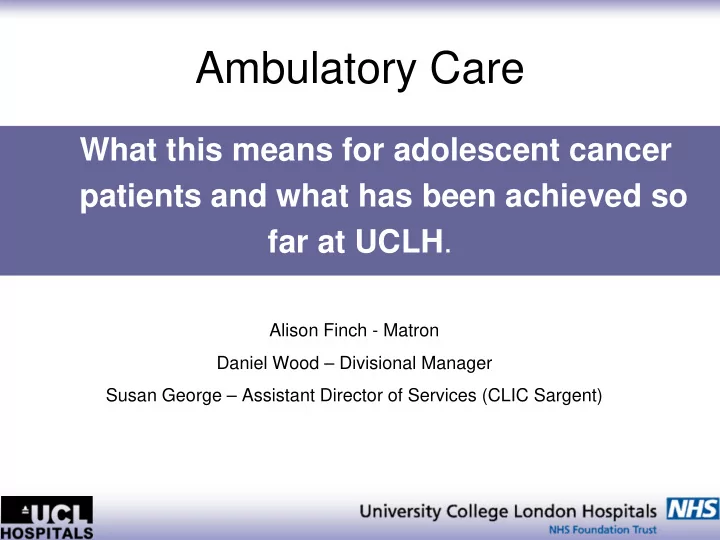

Ambulatory Care What this means for adolescent cancer patients and what has been achieved so far at UCLH . Alison Finch - Matron Daniel Wood – Divisional Manager Susan George – Assistant Director of Services (CLIC Sargent)
Overview • Our current service and ambulatory care • Advantages to both patients/hospital • Paul's House from a patient/family • Achievements so far • The Challenges • The Future – Cancer Centre
Children & Young People’s Cancer Service • Comprehensive children’s and teenage clinical services at UCH • > 5,200 attendances p.a. • Two entire floors of the UCH Tower 0-12 and 13-19 years • Age appropriate facilities including primary and secondary schools •1 st and largest Teenage Cancer Unit in the country
What is ambulatory care? • Past: patients receive cancer treatment as an inpatient • Memorial Sloan Kettering (in US) have pioneered Ambulatory Care: – Patients receive chemotherapy in hospital day care setting – Patients stay over night in a residential setting (not a hospital)
How do we achieve this? Paul’s House • http://uclh.madewithlovehq.com/13- 19/stories/ambulatory-service/
Advantage to our patients • Independence • Keeps families together • Normalises life during treatment • Choice and control over treatment • Increased Privacy • Works with our philosophy of care
Advantage to us • Treatment given when needed • Less reliance inpatient facilities (which saves money) • Better quality of patient experience • Freeing up inpatient beds to look after more inpatients
What have we achieved this year? • Paul’s House opened (Sept 2010) • Purchased back pack • Trained nurses • Changed clinical protocol • Working closely with Paul’s House with regard to environment and infection control • 1st ambulatory patient May
Challenges • Patient and staff understanding concept • Patient and family confidence to ambulate • Worry of over burdening families with need to self care • Capacity in Paul’s House • Patients desire to ambulate directly to home
The future - Cancer Centre
Summary •New model of care for young patients with cancer •Improved experience for patients and families •Excellent example of working in partnership with charitable organisations •A step to normalising cancer care
Recommend
More recommend